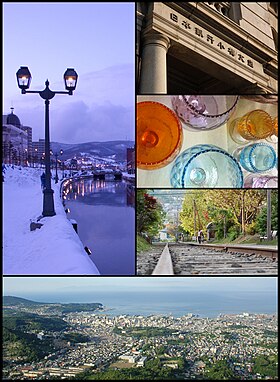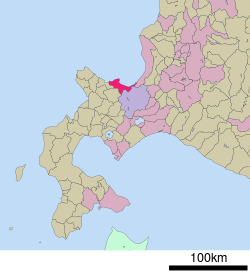Otaru
City in Hokkaido, Japan From Wikipedia, the free encyclopedia
City in Hokkaido, Japan From Wikipedia, the free encyclopedia
Otaru (小樽市, Otaru-shi) is a city and port in Shiribeshi Subprefecture, Hokkaido, Japan, northwest of Sapporo. The city faces Ishikari Bay and the Sea of Japan, and has long served as the main port of the bay. With its many historical buildings, Otaru is a popular tourist destination. Because it is a 25-minute drive from Sapporo, it has grown as a commuter town. As of July 31, 2023, the city had an estimated population of 107,432 and a population density of 441 persons per km² (1,100 persons per mi²). The total area is 243.83 km2 (94.14 sq mi). Although it is the largest city in Shiribeshi Subprefecture, the subprefecture's capital is the more centrally located Kutchan.
Otaru
小樽市 | |
|---|---|
 Top left: Otaru Canal Top right: The Bank of Japan Otaru Museum Middle right 1: - Glass Works in Otaru Middle right 2: - Temiya old railway line Bottom: - Vista from Mount Tengu | |
 Location of Otaru in Hokkaido | |
| Coordinates: 43°11′N 141°0′E | |
| Country | Japan |
| Region | Hokkaido |
| Prefecture | Hokkaido (Shiribeshi Subprefecture) |
| Government | |
| • Mayor | Toshiya Hazama (from August 2018) |
| Area | |
| • Total | 243.83 km2 (94.14 sq mi) |
| Population (July 31, 2023) | |
| • Total | 107,432 |
| • Density | 440/km2 (1,100/sq mi) |
| Time zone | UTC+9 (Japan Standard Time) |
| Phone number | 0134-32-4111 |
| Address | 2-12-1 Hanazono, Otaru-shi, Hokkaido 047-8660 |
| Climate | Dfb |
| Website | www.city.otaru.lg.jp |
| Symbols | |
| Bird | Aobato (Japanese Green Pigeon) |
| Flower | Azalea |
| Tree | Shirakaba (Siberian Silver Birch) |
The name "Otaru" is recognized as being of Ainu origin, possibly meaning "River running through the sandy beach". The very small remaining part of the Temiya Cave contains carvings from the Zoku-Jōmon period of Ainu history, around A.D. 400. Mount Akaiwa (Northwest part of Otaru) is memorialized in the Ainu tradition in the story of Sitonai, village chief's teenage daughter who had slain a white snake from the mountain's cave that demanded sacrifices of girls every year.[1][2] The legend explains the name of a big cave on Mount Akaiwa, Hakuryu Gongen Cave (白竜権現洞窟, lit. "White Dragon Gongen Cave") and the reason why a shrine was built on the mountain (to protect the village from being haunted by the snake).[2]
Otaru was recognised as a village by the bakufu in 1865, and in 1880 the first railway line in Hokkaido was opened with daily service between Otaru and Sapporo.
An Imperial decree in July 1899 established Otaru as an open port for trading with the United States and the United Kingdom.[3]
The city flourished well as the financial and business center in Hokkaido as well as the trade port with Japanese ruled southern Sakhalin until the 1920s. Otaru was redesignated as a city on August 1, 1922.
On December 27, 1924, a freight train loaded with 600 cases of dynamite, unloaded from the freighter Shoho Maru,[4] exploded in Temiya Station, killing 94 people and injuring 200 more, in addition to damaging the warehouse, the harbour facilities, and the surrounding area.[5]
During World War II, Otaru housed a prison camp for Aleuts taken there following the Japanese occupation of Attu.[6] During the closing stages of the war, Otaru was bombed by American naval aircraft in July 1945.[7]
Since the 1950s, as the coal industry around the city went into a decline, the status of the economic hub shifted from Otaru to Sapporo.
Otaru is a port town on the coast of the Sea of Japan in northern Shiribeshi Subprefecture. The southern portion of the city is characterized by the steep slopes of various mountains (notably Tenguyama), where the altitude of the land sharply drops from the mountains to the sea. The land available between the coast and mountains has been almost completely developed, and the developed part of the city on the mountain slopes is called Saka-no-machi, or "Hill town", including hills named Funamizaka (Boat-view Hill) and Jigokuzaka (Hell Hill).

Some of the rivers in Otaru are: Hoshioki, Kiraichi, Zenibako, Hariusu, Asari, Katsunai, Shioya, Myoken, Irifune.
In the summer the weather, like all of western Hokkaido, is very warm and balmy, with a maximum temperature of around 25 °C (77 °F) and high humidity – not as hot as southern Japan. In the winter, however, Otaru is very snowy, receiving as much as 6.6 metres (260 in) of snow from November to March, when it snows almost constantly and sunshine levels are extremely low. The average maximum snow cover is 1.22 metres (48 in). Extreme temperatures have ranged from 36.2 °C (97.2 °F) on July 28, 2021,[8] to −18.0 °C (−0.4 °F) on January 24, 1954, in which month the highest snowfall of 3.1 metres (122 in) occurred.[9] Monthly precipitation totals in a record dating back to 1943 have ranged from 379.8 millimetres (15.0 in) in August 1962 to 12.0 millimetres (0.5 in) in June 2007.[9]
| Climate data for Otaru, 1991–2020 normals, extremes 1943–present | |||||||||||||
|---|---|---|---|---|---|---|---|---|---|---|---|---|---|
| Month | Jan | Feb | Mar | Apr | May | Jun | Jul | Aug | Sep | Oct | Nov | Dec | Year |
| Record high °C (°F) | 11.0 (51.8) |
12.1 (53.8) |
16.9 (62.4) |
27.6 (81.7) |
30.2 (86.4) |
31.9 (89.4) |
36.2 (97.2) |
34.9 (94.8) |
33.6 (92.5) |
25.7 (78.3) |
21.8 (71.2) |
15.2 (59.4) |
36.2 (97.2) |
| Mean daily maximum °C (°F) | −0.5 (31.1) |
−0.2 (31.6) |
4.1 (39.4) |
10.9 (51.6) |
16.9 (62.4) |
20.4 (68.7) |
24.2 (75.6) |
25.6 (78.1) |
22.3 (72.1) |
15.9 (60.6) |
8.3 (46.9) |
1.6 (34.9) |
12.5 (54.4) |
| Daily mean °C (°F) | −3.1 (26.4) |
−2.7 (27.1) |
0.8 (33.4) |
6.5 (43.7) |
12.1 (53.8) |
16.0 (60.8) |
20.2 (68.4) |
21.7 (71.1) |
18.1 (64.6) |
11.8 (53.2) |
4.9 (40.8) |
−1.1 (30.0) |
8.8 (47.8) |
| Mean daily minimum °C (°F) | −5.8 (21.6) |
−5.7 (21.7) |
−2.4 (27.7) |
2.6 (36.7) |
7.9 (46.2) |
12.5 (54.5) |
17.1 (62.8) |
18.4 (65.1) |
14.3 (57.7) |
7.9 (46.2) |
1.6 (34.9) |
−3.8 (25.2) |
5.4 (41.7) |
| Record low °C (°F) | −18.0 (−0.4) |
−17.2 (1.0) |
−14.1 (6.6) |
−6.4 (20.5) |
0.0 (32.0) |
4.5 (40.1) |
9.0 (48.2) |
8.9 (48.0) |
2.6 (36.7) |
−1.4 (29.5) |
−9.1 (15.6) |
−13.5 (7.7) |
−18.0 (−0.4) |
| Average precipitation mm (inches) | 138.1 (5.44) |
106.6 (4.20) |
87.3 (3.44) |
56.4 (2.22) |
53.7 (2.11) |
55.6 (2.19) |
93.6 (3.69) |
131.3 (5.17) |
131.7 (5.19) |
123.0 (4.84) |
152.4 (6.00) |
151.9 (5.98) |
1,281.6 (50.47) |
| Average snowfall cm (inches) | 157 (62) |
130 (51) |
80 (31) |
7 (2.8) |
0 (0) |
0 (0) |
0 (0) |
0 (0) |
0 (0) |
0 (0) |
36 (14) |
142 (56) |
552 (216.8) |
| Average precipitation days (≥ 1.0 mm) | 22.8 | 18.6 | 16.1 | 10.0 | 9.0 | 7.4 | 8.3 | 9.6 | 11.3 | 14.1 | 18.1 | 21.7 | 167 |
| Average snowy days (≥ 1 cm) | 23.0 | 19.1 | 15.7 | 2.5 | 0 | 0 | 0 | 0 | 0 | 0.1 | 6.3 | 19.8 | 86.5 |
| Average relative humidity (%) | 71 | 70 | 66 | 64 | 69 | 78 | 81 | 78 | 73 | 69 | 69 | 71 | 72 |
| Mean monthly sunshine hours | 63.5 | 78.2 | 128.8 | 175.5 | 200.6 | 170.4 | 163.3 | 167.7 | 159.8 | 139.7 | 79.6 | 59.0 | 1,586.2 |
| Source: Japan Meteorological Agency[10][11] | |||||||||||||
| Name | In office |
|---|---|
| Tota Sayanagi (佐柳藤太) | August 16, 1923 - February 25, 1925 |
| Fumihiko Kitagawa (木田川奎彦) | September 19, 1925 - November 11, 1932 |
| Miyakichi Itaya (板谷宮吉) | December 11, 1933 - December 10, 1937 |
| Naotaka Kawahara (河原直孝) | April 5, 1938 – May 10, 1945 |
| Kokichi Fukuoka (福岡幸吉) | June 1, 1945 - November 12, 1946 |
| Eitaro Suhara (寿原英太郎) | April 2, 1947 - April 6, 1951 |
| Yogoro Adachi (安達与五郎) | April 25, 1951 - April 29, 1967 |
| Yu Inagaki (稲垣祐) | April 30, 1967 - April 29, 1975 |
| Kazuo Shimura (志村和雄) | April 30, 1975 - April 29, 1987 |
| Masaaki Shintani (新谷昌明) | April 30, 1987 - April 29, 1999 |
| Katsuma Yamada (山田勝麿) | April 30, 1999 - April 29, 2011 |
| Yoshiharu Nakamatsu (中松義治) | April 30, 2011 - April 29, 2015 |
| Hideaki Morii (森井秀明) | April 30, 2015 - August 25, 2018 |
| Toshiya Hazama (迫俊哉) | August 26, 2018 - present |
This section needs additional citations for verification. (March 2021) |

A canal adorned with Victorian-style street lamps runs through Otaru. The city attracts a large number of Japanese tourists as well as Chinese, Korean and others.
A popular attraction on the west side of the city is Nishin Goten (herring mansion). This large wooden building was built in 1897 and was once the house of Fukumatsu Tanaka, a magnate of the fishing industry. It was originally built in nearby Tomari village and moved in 1958. Visitors can clearly see the difference between the squalid conditions of the first floor sleeping quarters of 120 workers and the ground floor luxury of the magnate's rooms.
Another notable building is the Sakaushi residence, constructed by Yoshiya Tanoue, a pupil of Frank Lloyd Wright.[12][13]
It is home to the Otaru Aquarium and has long been one of Otaru's most popular tourist attractions. Otaru Aquarium, recognized by the Ministry of Education, Culture, Sports, Science and Technology as a facility equivalent to a museum under the Museum Law, is the oldest existing aquarium in Hokkaido, having opened in 1958.[14][15]
The Tomioka Catholic church is also a popular spot. Many of the buildings have been designated as landmark architecture.[16][clarification needed]
Otaru is well known for its beer, and Otaru Beer, next to the canal, is a popular restaurant with a medieval theme. Otaru is also known for its fresh sushi. Another food attraction unique to Otaru is the rainbow tower ice cream. The town also has substantial shopping arcades and bazaars, but fewer than nearby Sapporo.
Otaru's prominent industries are arts and crafts, such as studio glass and musical boxes. Of the latter, it maintains the Otaru Music Box Museum. Otaru Art Base is another cluster of museums that showcases local art.[17]

Otaru is an important port for Sapporo, and part of this hilly city is on the lower slopes of Tenguyama, a good place for skiing and other winter sports and one that is accessible via Otaru Tenguyama Ropeway.
Otaru Ankake Yakisoba is a regional variety of the popular Ankake Yakisoba dish that is an important part of the local cuisine and is a draw for tourists.[18]
Seamless Wikipedia browsing. On steroids.
Every time you click a link to Wikipedia, Wiktionary or Wikiquote in your browser's search results, it will show the modern Wikiwand interface.
Wikiwand extension is a five stars, simple, with minimum permission required to keep your browsing private, safe and transparent.